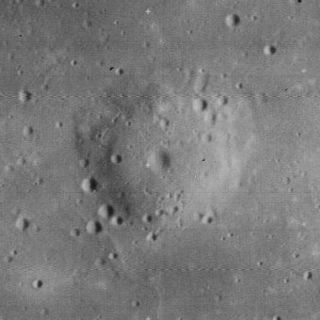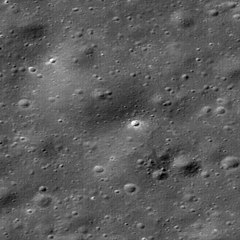
Lunokhod 1 was the first of two robotic lunar rovers landed on the Moon by the Soviet Union as part of its Lunokhod program. The Luna 17 spacecraft carried Lunokhod 1 to the Moon in 1970. Lunokhod 1 was the first remote-controlled robot "rover" to freely move across the surface of an astronomical object beyond the Earth. It was also the first wheeled craft on another celestial body. Lunokhod 0 (No.201), the previous and first attempt to do so, launched in February 1969 but failed to reach orbit.

Lunokhod 2 was the second of two unmanned lunar rovers that landed on the Moon by the Soviet Union as part of the Lunokhod programme.

Mare Imbrium is a vast lava plain within the Imbrium Basin on the Moon and is one of the larger craters in the Solar System. The Imbrium Basin formed from the collision of a proto-planet during the Late Heavy Bombardment. Basaltic lava later flooded the giant crater to form the flat volcanic plain seen today. The basin's age has been estimated using uranium–lead dating methods to approximately 3.9 billion years ago, and the diameter of the impactor has been estimated to be 250 ± 25 km. The Moon's maria have fewer features than other areas of the Moon because molten lava pooled in the craters and formed a relatively smooth surface. Mare Imbrium is not as flat as it was originally thought, because later events have altered its surface.

Copernicus is a lunar impact crater located in eastern Oceanus Procellarum. It was named after the astronomer Nicolaus Copernicus. It typifies craters that formed during the Copernican period in that it has a prominent ray system. It may have been created by debris from the breakup of the parent body of asteroid 495 Eulalia 800 million years ago.

Archimedes is a large lunar impact crater on the eastern edges of the Mare Imbrium. Its diameter is 81 km.

A lunar dome is a type of shield volcano that is found on the surface of the Earth's Moon. They are typically formed by highly viscous, possibly silica-rich lava, erupting from localized vents followed by relatively slow cooling. Lunar domes are wide, rounded, circular features with a gentle slope rising in elevation a few hundred meters to the midpoint. They are typically 8–12 km in diameter, but can be up to 20 km across. Some of the domes contain a small craterlet at the peak.

Sinus Iridum is a plain of basaltic lava that forms a northwestern extension to the Mare Imbrium on Earth's moon. It is surrounded from the northeast to the southwest by the Montes Jura range. The protruding part of the range at the southwest end is named Promontorium Heraclides, while that at the northeast end is called Promontorium Laplace. This bay and the surrounding mountains is considered one of the most beautiful features on the Moon, and is a favorite among lunar observers.

The Lunar Reconnaissance Orbiter (LRO) is a NASA robotic spacecraft currently orbiting the Moon in an eccentric polar mapping orbit. Data collected by LRO have been described as essential for planning NASA's future human and robotic missions to the Moon. Its detailed mapping program is identifying safe landing sites, locating potential resources on the Moon, characterizing the radiation environment, and demonstrating new technologies.

Hadley–Apennine is a region on the near side of Earth's Moon that served as the landing site for the American Apollo 15 mission, the fourth manned landing on the Moon and the first of the "J-missions", in July 1971. The site is located on the eastern edge of Mare Imbrium on a lava plain known as Palus Putredinis. Hadley–Apennine is bordered by the Montes Apenninus, a mountain range, and Hadley Rille, a meandering channel, on the east and west, respectively.

Slava is a tiny crater on the Moon. It is near the site where Soviet lunar rover Lunokhod 1 landed in November 1970, in the Mare Imbrium region. Its diameter is 0.1 km. The name Slava does not refer to a specific person; it is a Slavic male name, a diminutive form of Yaroslav and other names.

Nikolya is a tiny crater on the Moon. It is near the site where Soviet lunar rover Lunokhod 1 landed in November 1970, in the Mare Imbrium region. Its diameter is 0.12 km. The name Nikolya does not refer to a specific person; it is a male name of Russian origin, a diminutive form of Nikolai.

Igor is a tiny crater on the Moon. It is near the site where Soviet lunar rover Lunokhod 1 landed in November 1970, in the Mare Imbrium region. Its diameter is 0.1 km. The name Igor does not refer to a specific person; it is a Russian male name, derived from the Norse name Ingvar.

Gena is a tiny crater on the Moon. It is near the site where Soviet lunar rover Lunokhod 1 landed in November 1970, in the Mare Imbrium region. Its diameter is 0.2 km. The name Gena does not refer to a specific person; it is a male name of Russian origin, a diminutive form of Gennady.

Borya is a tiny crater on the Moon. It is near the site where Soviet lunar rover Lunokhod 1 landed in November 1970, in the Mare Imbrium region. Its diameter is 0.4 km (0.25 mi). The name Borya does not refer to a specific person; it is a male name of Russian origin, the diminutive form of Boris.

Vitya is a tiny crater on the Moon. It is near the site where Soviet lunar rover Lunokhod 1 landed in November 1970, in the Mare Imbrium region. Its diameter is 0.13 km. The name Vitya does not refer to a specific person; it is a Russian male name, a diminutive form of Victor.

Kostya is a tiny crater on the Moon. It is near the site where Soviet lunar rover Lunokhod 1 landed in November 1970, in the Mare Imbrium region. Its diameter is 0.13 km. The name Kostya does not refer to a specific person; it is a male name of Russian origin, a diminutive form of Konstantin.

Valera is a tiny crater on the Moon. It is near the site where Soviet lunar rover Lunokhod 1 landed in November 1970, in the Mare Imbrium region. Its diameter is 0.13 km. The name Valera does not refer to a specific person; it is a Russian male name, a diminutive form of Valery.

Kolya is a tiny crater on the Moon. It is near the site where Soviet lunar rover Lunokhod 1 landed in November 1970, in the Mare Imbrium region. Its diameter is 0.14 km. The name Kolya does not refer to a specific person; it is a male name of Russian origin, a diminutive form of Nikolai.

Albert is a tiny crater on the Moon. It is near the site where Soviet lunar rover Lunokhod 1 landed in November 1970, in the Mare Imbrium region. Its diameter is 0.1 km. The name Albert does not refer to a specific person; it is a male name of German origin.

Leonid is a tiny crater on the Moon. It is near the site where Soviet lunar rover Lunokhod 1 landed in November 1970, in the Mare Imbrium region. Its diameter is 0.12 km. The name Leonid does not refer to a specific person; it is a Russian male name of Greek origin.













